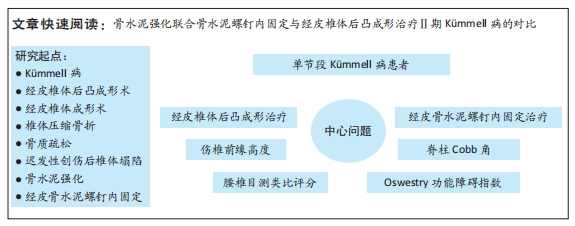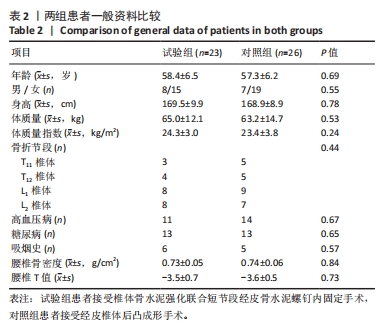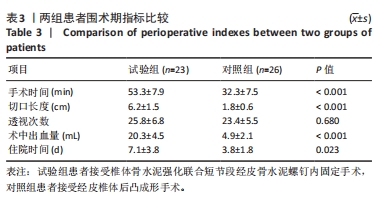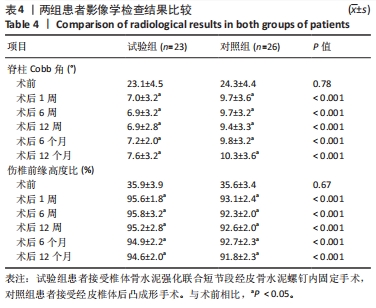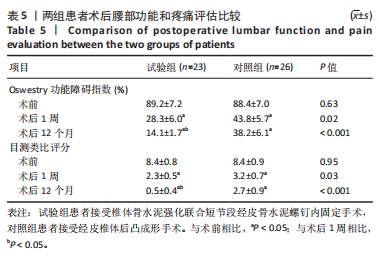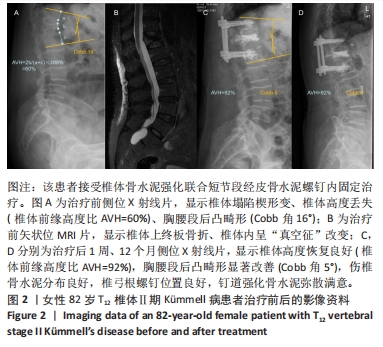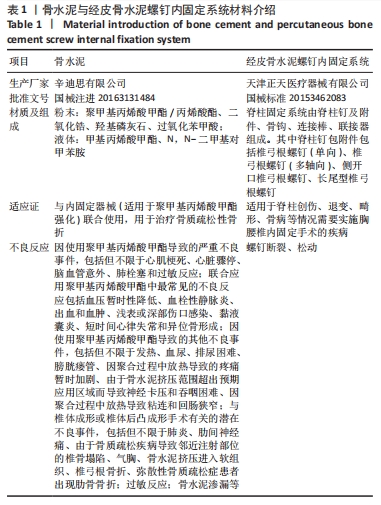[1] ZHANG X, HU W, YU J, et al. An Effective Treatment Option for Kümmell Disease With Neurological Deficits: Modified Transpedicular Subtraction and Disc Osteotomy Combined With Long-Segment Fixation. Spine (Phila Pa 1976). 2016;41(15):E923-E930.
[2] 姚汝斌,王仕永,杨开舜.椎弓根内骨水泥灌注联合椎体后凸成形治疗Kummell病:增强椎体内骨水泥团块稳定性[J].中国组织工程研究,2021,25(28):4435-4440.
[3] PAN D, CHEN D. Comparison of Unipedicular and Bipedicular Percutaneous Kyphoplasty for Kummell’s Disease. Geriatr Orthop Surg Rehabil. 2022;13:215.
[4] KOU YH, ZHANG DY, ZHANG JD, et al. Vertebroplasty with high-viscosity cement versus conventional kyphoplasty for osteoporotic vertebral compression fractures: a meta-analysis. ANZ J Surg. 2022;92(11): 2849-2858.
[5] ZHANG JQ, ZENG ZY, LU HG, et al. A comparative study of PSPVP and PSIBG in the treatment of stage II-III Kummell’s disease. Biomed Mater Eng. 2023;34(3):261-276.
[6] MO GY, ZHOU TP, GUO HZ, et al. Long-term efficacy and safety of bone cement-augmented pedicle screw fixation for stage III Kümmell disease. Sci Rep. 2021;11(1):13647.
[7] 詹乙,康鑫,王宇航,等.新型骨水泥螺钉与传统方式治疗Kummell病的生物力学分析[J].中国组织工程研究,2022,26(21):3381-3388.
[8] CABRERA JP, CAMINO-WILLHUBER G, GUIROY A, et al. Vertebral augmentation plus short-segment fixation versus vertebral augmentation alone in Kümmell’s disease: a systematic review and meta-analysis. Neurosurg Rev. 2022;45(2):1009-1018.
[9] 钱冰,郝定均,郑永宏,等.两种术式治疗不稳定型Kümmell病的疗效比较[J].中国修复重建外科杂志,2017,31(2):185-190.
[10] ZHANG GQ, GAO YZ, ZHENG J, et al. Posterior decompression and short segmental pedicle screw fixation combined with vertebroplasty for Kümmell’s disease with neurological deficits. Exp Ther Med. 2013; 5(2):517-522.
[11] LEE SH, KIM ES, EOH W. Cement augmented anterior reconstruction with short posterior instrumentation: a less invasive surgical option for Kummell’s disease with cord compression. J Clin Neurosci. 2011; 18(4):509-514.
[12] SHENG W, JIANG H, HONG C, et al. Comparison of outcome between percutaneous pedicle screw fixation and the Mini-Open Wiltse Approach with pedicle screw fixation for neurologically intact thoracolumbar fractures: A retrospective study. J Orthop Sci. 2022;27(3):594-599.
[13] SHEN H, TANG W, YIN X, et al. Comparison between percutaneous short-segment fixation and percutaneous vertebroplasty in treating Kummell’s disease: A minimum 2-year follow-up retrospective study. J Back Musculoskelet Rehabil. 2024;37(1):195-203.
[14] KO MJ, LEE BJ. Kummell’s Disease is Becoming Increasingly Important in an Aging Society: A Review. Korean J Neurotrauma. 2023;19(1):32-41.
[15] CHANG JZ, BEI MJ, SHU DP, et al. Comparison of the clinical outcomes of percutaneous vertebroplasty vs. kyphoplasty for the treatment of osteoporotic Kümmell’s disease:a prospective cohort study. BMC Musculoskelet Disord. 2020;21(1):238.
[16] ZHONG S, BAO F, FAN Q, et al. Prevention of Bone Cement Displacement in Kümmell Disease without Neurological Deficits through Treatment with a Novel Hollow Pedicle Screw Combined with Kyphoplasty. Orthop Surg. 2023;15(10):2515-2522.
[17] 张建乔,胡旭琪,俞伟,等.椎体成形术联合短节段椎弓根螺钉内固定治疗Ⅱ、Ⅲ期Kümmell病[J].脊柱外科杂志,2023,21(6):361-367.
[18] 张钟巍,苟鹏国,张志国,等.Kümmell病的研究进展[J].脊柱外科杂志,2024,22(2):129-134.
[19] DAI S, DU Y, CHEN L, et al. A mid- and long-term follow-up study on the bilateral pedicle anchoring technique with percutaneous vertebroplasty for the treatment of Kümmell’s disease. Front Surg. 2023;10:1061498.
[20] 占方彪,谢鲤钟,邹鑫森,等.经皮椎体后凸成形与后路椎弓根钉内固定椎体强化治疗Kummell病有效与安全性的Meta分析[J].中国组织工程研究,2020,24(33):5397-5404.
[21] KUPPAN N, MUTHU S, PARTHASARATHY S, et al. Strategies in the Management of Osteoporotic Kummell’s Disease. J Orthop Case Rep. 2022;12(10):34-38.
[22] 吕游,张超,刘玥.阶梯序贯式椎体成形术在Kummell病治疗中的临床应用[J].中国骨与关节杂志,2024,13(1):17-20.
[23] LIU T, GU G, ZHAN C, et al. Comparison of percutaneous vertebroplasty and percutaneous vertebroplasty combined with pediculoplasty for Kümmell’s disease: a retrospective observational study. J Orthop Surg Res. 2023;18(1):471.
[24] GUO J, BAI Y, LI L, et al. A Comparative Study of 2 Techniques to Avoid Bone Cement Loosening and Displacement After Percutaneous Vertebroplasty Treating Unstable Kummell Disease. Neurospine. 2024;21(2):575-587.
[25] GAO X, DU J, ZHANG Y, et al. Predictive Factors for Bone Cement Displacement following Percutaneous Vertebral Augmentation in Kümmell’s Disease. J Clin Med. 2022;11(24):7479.
[26] KAN DJ, HAN DP, WANG JH, et al. Efficacy and Safety of High-Viscosity Bone Cement in Percutaneous Vertebroplasty for Kummell’s Disease. Indian J Orthop. 2024;58(5):575-586.
[27] CABRERA JP, CAMINO-WILLHUBER G, GUIROY A, et al. Vertebral augmentation plus short-segment fixation versus vertebral augmentation alone in Kümmell’s disease: a systematic review and meta-analysis. Neurosurg Rev. 2022;45(2):1009-1018.
[28] NING Y, LI Z, HUANG J, et al. Comparison of the Clinical Efficacy and Bone Cement Distribution Difference Between Kummell’s Disease and Osteoporotic Vertebral Compression Fracture After Percutaneous Kyphoplasty. Pain Physician. 2024;27(3):E327-E336.
[29] BAE J, ANG CY, SYED I, et al. Minimally Invasive Surgery Transpedicular Intrabody Cage Technique for the Management of Kummell Disease. Int J Spine Surg. 2024;18(1):73-80.
[30] ZHAN Y, BAO C, YANG H, et al. Biomechanical analysis of a novel bone cement bridging screw system combined with percutaneous vertebroplasty for treating Kummell’s disease. Front Bioeng Biotechnol. 2023;11:1077192.
[31] PAN D, CHEN D. Comparison of Unipedicular and Bipedicular Percutaneous Kyphoplasty for Kummell’s Disease. Geriatr Orthop Surg Rehabil. 2022;13:21514593221099264. |
